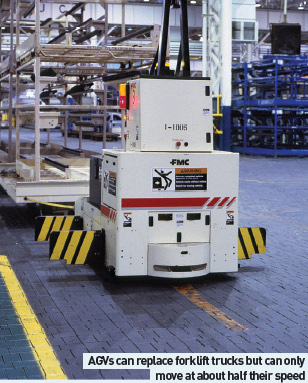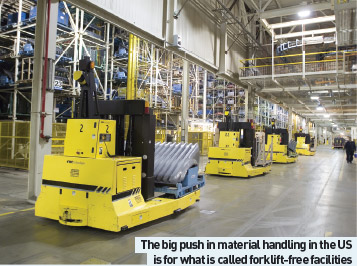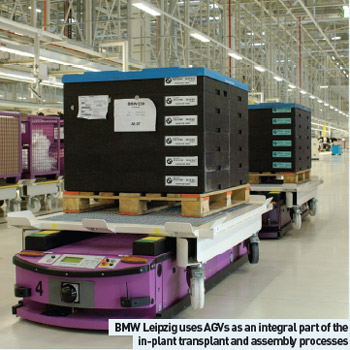In age of increased automation, getting parts to the assembly line in a reliable way has led to an increase in the use of automated guided vehicles. AMS looks at the latest developments in material handling and the safety advantages of the AGV.
In age of increased automation, getting parts to the assembly line in a reliable way has led to an increase in the use of automated guided vehicles. AMS looks at the latest developments in material handling and the safety advantages of the AGV.
At one time it appeared that automated guided vehicles (AGVs) would become all-pervasive in automotive manufacturing operations, with early installations such as Ford’s Cologne plant setting the standard. Over time, however, they have developed their own niche alongside traditional material handling options such as forklift trucks and fixed path conveyors.
Various companies have entered the arena and tried to forge a unique product line, resulting in a variety of different acronyms. Caterpillar, for instance, refers to its SGVs – self-guided vehicles (somewhat of a misnomer) or even its LGVs – Laser Guided Vehicles . But in essence they are the same.
One leading company using AGVs is US-based FMC Technologies. “The trends are to automate more of the process, right from unloading trucks to complete delivery at the assembly line,” says Greg Pachuta, Automotive Industry Manager at the company. “That is what we have done recently and I think it is going to continue to a totally hands-free delivery system.
“The vast majority of the AGV systems that are purchased in the US are mature delivery system rather than assembly systems. The big push in the US for material handling is what they call forklift-free facilities; the auto companies want to totally eliminate fork trucks in their plants, mainly for safety reasons. They feel that AGV systems are much safer vehicles. With all the safety devices, we can deliver material to the line with a much safer approach.”
Despite Pachuta’s assertion, it is clear that AGVs have their limitations. So what roles are AGVs particularly suited for? In applications where the throughput, relative to the distances travelled, are in the low to medium range and do not warrant fixed path conveyors, AGVs are ideal.
However, if the throughput is very low it can be best served with a manual delivery method such as a forklift truck, while high throughput requirements are better suited to a conveyor or towline.
Lifting, stacking and loading are also functions that are best accommodated by manual forklift trucks. In a properly designed system, forklifts are reserved for specific areas of a facility. The standardised size of the load is another important factor. For AGVs to be effective the load profile needs to be relatively consistent, in fact many integrators would say that a common load footprint, which allows repeat interface by an AGV, is a fundamental requirement.
 On the plus side, one key selling point for AGVs is their flexibility, something that is key in the modern manufacturing environment. Changes can easily be made in the route of an AGV – a simple matter of adding a few more laser locators or reprogramming the server – while altering fixed conveyors would take a huge investment.
On the plus side, one key selling point for AGVs is their flexibility, something that is key in the modern manufacturing environment. Changes can easily be made in the route of an AGV – a simple matter of adding a few more laser locators or reprogramming the server – while altering fixed conveyors would take a huge investment.
It is no surprise then that most facilities utilise AGVs as part of an overall material handling system but Pachuta is clear that there are no limits as to how many AGVs you can have on a plant. Demand will always be high if productivity levels are to be maintained, given that AGVs move with half the speed of a forklift truck. But he goes on: “The keys are the flexibility, the safety and the reliability.
You are taking people out of the equation so you need the vehicles to be reliable, to get the parts to the assembly line on time.”
The system operation is fairly consistent in all applications in that it features a server, a communications link and the vehicle itself. Pachuta explains: “You have the server that can communicate with the vehicles through the RF system, and then the vehicles take their destinations from the server.
The server doesn’t only give the vehicles their destinations but monitors them and can tell people on the plant floor where the vehicles are at all times. It also indicates what their status is, what their battery level is, and it performs the intersection blocking, so that it stops one vehicle to allow another through.
“The server gets information directly from a plc network. If an operator needs a new part he pushes a button which sends a call to our system to tell us to deliver another load to that location.”
Most modern AGVs are laser guided above the floor. There are laser targets on the building columns, which are nothing more than a piece of reflective tape or aluminium. “We put those targets on the building columns and then take the information – the path that we want the vehicles to follow – and we draw that with a programme that we call Layout Wizard,” Pachuta adds. “We draw the vehicle’s intended path and then use the laser targets to verify that it is on the path that it is supposed to be on.”
In the past the AGVs would have been wire guided, a time consuming, expensive and restrictive practice that involved burying a wire in the floor on the vehicle’s path. But nowadays there are really two main types of driving systems. You have general guided, a system that utilises magnets in the floor every thirty feet, and then there is laser guided. According to Pachuta the vast majority of the systems are laser guided because it is much more accurate and more reliable.
“With our systems there is nothing in the floor, so the vehicles can travel around the floor as it is,” he continues.
“One of the problems with the old wire guided system was that if you wanted to change it, you had to shut down the whole facility to change the path. With laser systems you can change the path while the plant is operating on a daily basis if you want to. Auto companies want no monuments, nothing bolted to the floor; everything has to be very fluid and flexible.”

When it comes to challenges that are faced in installing an automated system Pachuta is keen to dispel one myth – that AGVs need perfect floors. “The floor is typically not a problem,” he says. “There are things like larger wheels that we use to get over rough floor. The biggest challenges are narrow aisles where you need room to manoeuvre.
We must have clear aisles to be able to manoeuvre around the plant. This is usually a benefit because we force good housekeeping in the plant and they have to keep their aisles clear for the vehicles to travel.”
Safety is consistently a concern in manufacturing operations and even more so in automotive plants, and safety is where AGVs score heavily. They move at a slower rate than manually operated industrial vehicles. In addition, they operate on a fixed path and have safety features such as safety sensors, built in for pedestrian interaction.
“There are safety sensors called Sick Lasers that are on the front and rear of the vehicles (or any direction that the vehicle is travelling in),” Pachuta says. “These will sense a person three metres out and it will stop until that person has moved out of the way and then the vehicle will start back up again.”
One of the most impressive uses of AGVs is the marriage operation at the BMW Leipzig plant in Germany, where they are an integral part of the assembly process. AGVs deliver the engine and transmission units, which are assembled off site, and literally drive under the chassis for the marriage operation to take place. These deliveries take place in sequence so that the correct engine awaits each chassis.
“I have been to the BMW plant and there are two systems,” Pachuta says. “There is one that I call a ‘marriage system’ where they assemble the car right on board the vehicle, a portion of the car, and then it is pushed up to the car. Then there is a very simple system for delivering carts of parts around the plant. In most cases we are delivering parts around the plant as opposed to the cars being assembled by our vehicles. It is more of a handling rather than an assembly system.
“One new system that we are working on is at the DCX Belvidere facility in Illinois. It is one of our larger systems. We deliver engines right off the truck, which is automatically unloaded, and we take it right to the assembly line. There is no human contact from when it is built at another factory to when it gets to the assembly line.”
While not new, Ford’s Dearborn stamping plant is nevertheless a productive plant producing the body and underbody panels for the important F-150 pickup. It transforms some 600 tons of steel into parts and assemblies, and unusually for a stamping plant, it is a two level facility, with presses on both levels.
“Blanks are brought up from a market area in the basement by a self-guided vehicle based on a call system,” says Plant Manager Frank Piazza. “The blanks are removed with a forklift and placed on a cart, from which the press is fed. When the parts are finished, and we are running at a rate of over 700 per hour, there is an elevator system that holds racks. The racks are filled by the press, and then sent back down to the basement, where they are unloaded via AGVs.
“Because worker safety is a paramount consideration, a decision was made to have that arrangement for finished parts rather than having forklifts moving around where most of the workers are located at the press site.”
The automated handling system was installed in 2003 and features five Unit Load AGVs and eight tuggers that are laser guided over a 1 1/8 mile route moving 12,000 door panels per day.
Unit Load AGVs are the most traditional type of automated guided vehicle, sometimes referred to as a “top carrier” because the load rests over the majority of the vehicle. The vehicle typically interfaces with stands and conveyors or it is loaded by other manual or automatic equipment.
The Tug/Tow type AGV is an excellent choice for moving wheeled trailers or carts. The vehicle has a hydraulic latch that automatically engages and disengages the items to be towed. Depending on the load, several carts can be towed, minimising the number of cycles and vehicles required. Standard loads are up to 18,000kg. The dimensions of the Tug/Tow vehicle vary with the load weight and dimensions.
According to Ford, the benefits are increased uptime and production time for the stamping press, a flexible solution for the plant’s changing production demands, a safe, fork-free, reliable method for delivery of steel blanks and door panels, as well as the utilisation of previously unused plant space.
On the first floor of the plant, a Unit Load AGV backs into a pickup station where steel blanks are lowered onto its flat deck. That AGV follows a path to a ramp that connects the first floor to the second floor of the facility. It then proceeds to one of two deposit stations where it leaves the steel or transfers it to the press for stamping into door or hood panels.
A continuous belt conveyor then delivers panels individually from the press to one of three shuttle conveyors. Here, workers manually unload each panel and stack it into a special rack. On the first floor, a tugger AGV pulls into position alongside the staged racks, which are indexed onto a trailer. Each tugger pulls three trailers of racks.
The tugger pulls the trailers from the pickup station to the work in-process market where they are staged on three-high racks to be picked up for assembly and shipment.
In Ohio, at DaimlerChrysler’s Toledo North Assembly Plant, the Jeep Liberty and Dodge Nitro are produced. Close on 3,000 workers ply their trade at the 2.1 million square foot facility, and it is on Jeep production that AGVs are chiefl y utilised.
Racks of stamped parts are off loaded at several docks onto gravity fed conveyors. A total of 22 SGVs deliver full racks to 32 over and under conveyors. Indexing of the conveyors creates the automatic demand for additional SGV delivered parts, while empty racks are then returned by SGV to the originating dock for return to vendor.
The systems completes 1,152 deliveries each day of 32 parts and since its installation has enjoyed a 99.8 per cent system uptime. The laser guided vehicles travel on 12,000 feet of vehicle path.




































